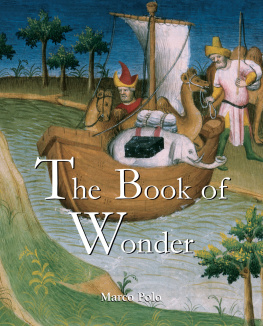Who Was
Marco Polo?
Who Was
Marco Polo?

By Joan Holub
Illustrated by John OBrien
Grosset & Dunlap
For George Hallowell, who makes traveling funJ.H.
For LindaJ.O.B.
GROSSET & DUNLAP
Published by the Penguin Group
Penguin Group (USA) Inc., 375 Hudson Street, New York, New York 10014, U.S.A.
Penguin Group (Canada), 90 Eglinton Avenue East, Suite 700, Toronto,
Ontario, Canada M4P 2Y3 (a division of Pearson Penguin Canada Inc.)
Penguin Books Ltd, 80 Strand, London WC2R 0RL, England
Penguin Ireland, 25 St Stephens Green, Dublin 2, Ireland
(a division of Penguin Books Ltd)
Penguin Group (Australia), 250 Camberwell Road,
Camberwell, Victoria 3124, Australia (a division of Pearson Australia Group Pty Ltd)
Penguin Books India Pvt Ltd, 11 Community Centre,
Panchsheel Park, New Delhi110 017, India
Penguin Group (NZ), 67 Apollo Drive, Mairangi Bay, Auckland 1311,
New Zealand (a division of Pearson New Zealand Ltd)
Penguin Books (South Africa) (Pty) Ltd, 24 Sturdee Avenue,
Rosebank, Johannesburg 2196, South Africa
Penguin Books Ltd, Registered Offices: 80 Strand, London WC2R 0RL, England
If you purchased this book without a cover, you should be aware that this book is stolen property. It was reported as unsold and destroyed to the publisher, and neither the author nor the publisher has received any payment for this stripped book.
The scanning, uploading, and distribution of this book via the Internet or via any other means without the permission of the publisher is illegal and punishable by law.
Please purchase only electronic editions and do not participate in or encourage electronic piracy of copyrighted materials. Your support of the authors rights is appreciated.
The publisher does not have any control over and does not assume
any responsibility for author or third-party websites or their content.
Text copyright 2007 by Joan Holub. Illustrations copyright 2007 by John OBrien.
Cover illustration copyright 2007 by Nancy Harrison. All rights reserved.
Published by Grosset & Dunlap, a division of Penguin Young Readers Group,
345 Hudson Street, New York, New York 10014.
GROSSET & DUNLAP is a trademark of Penguin Group (USA) Inc.
Printed in the U.S.A.
Library of Congress Control Number: 2006038243
Who Was
Marco Polo?

Marco Polo lived in Venice, Italy, more than seven hundred fifty years ago. Back then, in the 1200s, most people spent their whole lives right where they were born. But not Marco. He made an eleven-thousand-mile trip to China and back. And he became the most famous traveler in Europe. Not just because he made such a long and dangerous trip (although hardly anyone else in Europe had done this at the time), but because he wrote a book about his adventure.

Like his father and uncle, Marco was a merchant. The Polos wanted to go to Asia to bring back silk, spices, and other expensive goods to sell in Europe. Marco was a teenager when he went off to China. He didnt return to Italy for twenty-four years!

Chinas ruler was named Kublai Kahn (KOO-bluh kahn). He liked Marco and sent him to nearby countries to spy. Marco took notes about the places he saw and the customs of the people he met. He used these notes to write a book about his travels. Reading his book was the way many Europeans learned about Asia.

Two hundred years later, explorers such as Christopher Columbus and Vasco de Gama read Marcos book. It made them want to reach Asia, too. But they hoped to find an easier route.

Was everything in Marcos book true? Historians think he exaggerated here and there. Some even think he never went to China at all. Still, his book made him famous around the world.
What is the true story of Marco Polo?

Chapter 1
A Family of Merchants
Two things made the year 1254 important in Marco Polos life. First, it was the year he was born. And second, it was the year his father, who was named Niccolo, and his uncle Maffeo left Venice on a trading trip to Asia. Marcos father was gone so long that Marco was fifteen years old when they met for the first time!
Soon after Marco was born, his mother died. He was sent to live with relatives. As a boy, he didnt spend much time in school. Instead, his family taught him things he needed to know to become a merchant.
For instance, Venetians used coins such as silver grossos and gold ducats (DUK-ets). Marco needed to know how to weigh the coins correctly. Venetians had their own measuring system. It was based on using their hands and feet. For instance, one palm was about nine and a half inches. Cloth would have been measured in palms. Other countries used different kinds of money and measurements. Marco needed to learn about them, too. Otherwise, merchants could cheat him.


The sailors and merchants Marco met on Venices docks also taught him about trading. Venice was the most powerful trading city in the world. Its busy port, with ships constantly coming and going, was on the Adriatic Sea.
Venice was not like most cities. It was actually a group of 118 tiny islands connected by canals. Marco and his family traveled the canals in long canoelike boats called gondolas (GAHN-doh-lahz).


Back then Italy was not a country. It was a group of city-states. Each city-state ruled itself. Venice was one of the largest, with as many as one hundred thousand people.

Venice sold its productswood, wheat, and saltto foreign lands. Salt was very valuable in those days. And lots of it washed up on Venices shores. Since there were no refrigerators, salt was used to keep fish and meat from rotting. Without salt, they rotted within a week. But salted, these foods could last for months. This was very important on long trips at sea.


























